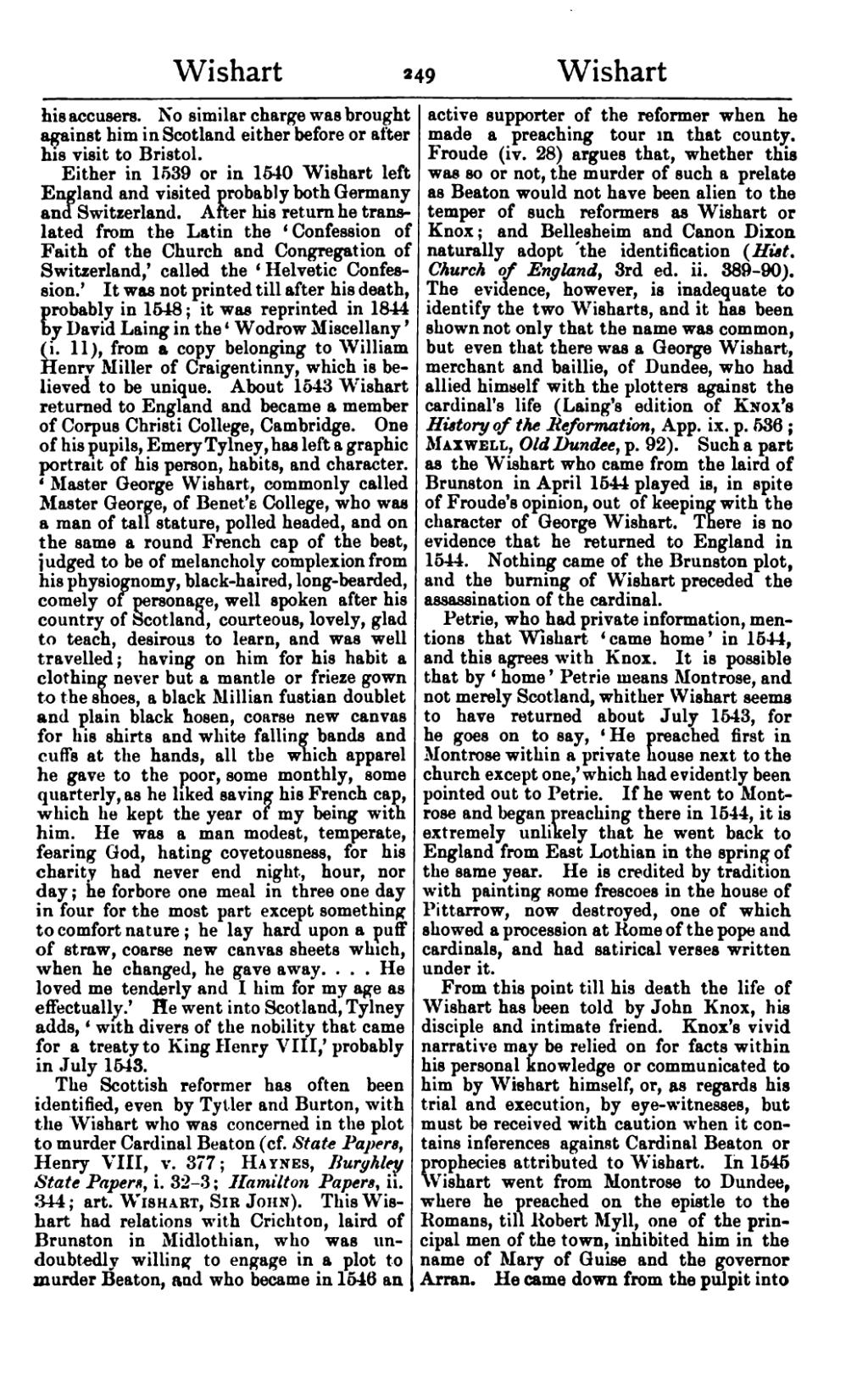his accusers. No similar charge was brought against him in Scotland either before or after his visit to Bristol.
Either in 1539 or in 1540 Wishart left England and visited probably both Germany and Switzerland. After his return he translated from the Latin the ‘Confession of Faith of the Church and Congregation of Switzerland,’ called the ‘Helvetic Confession.’ It was not printed till after his death, probably in 1548; it was reprinted in 1844 by David Laing in the ‘Wodrow Miscellany’ (i. 11), from a copy belonging to William Henry Miller of Craigentinny, which is believed to be unique. About 1543 Wishart returned to England and became a member of Corpus Christi College, Cambridge. One of his pupils, Emery Tylney, has left a graphic portrait of his person, habits, and character. ‘Master George Wishart, commonly called Master George, of Benet's College, who was a man of tall stature, polled headed, and on the same a round French cap of the best, judged to be of melancholy complexion from his physiognomy, black-haired, long-bearded, comely of personage, well spoken after his country of Scotland, courteous, lovely, glad to teach, desirous to learn, and was well travelled; having on him for his habit a clothing never but a mantle or frieze gown to the shoes, a black Millian fustian doublet and plain black hosen, coarse new canvas for his shirts and white falling bands and cuffs at the hands, all the which apparel he gave to the poor, some monthly, some quarterly, as he liked saving his French cap, which he kept the year of my being with him. He was a man modest, temperate, fearing God, hating covetousness, for his charity had never end night, hour, nor day; he forbore one meal in three one day in four for the most part except something to comfort nature; he lay hard upon a puff of straw, coarse new canvas sheets which, when he changed, he gave away. … He loved me tenderly and I him for my age as effectually.’ He went into Scotland, Tylney adds, ‘with divers of the nobility that came for a treaty to King Henry VIII,’ probably in July 1543.
The Scottish reformer has often been identified, even by Tytler and Burton, with the Wishart who was concerned in the plot to murder Cardinal Beaton (cf. State Papers, Henry VIII, v. 377; Haynes, Burghley State Papers, i. 32–3; Hamilton Papers, ii. 344; art. Wishart, Sir John). This Wishart had relations with Crichton, laird of Brunston in Midlothian, who was undoubtedly willing to engage in a plot to murder Beaton, and who became in 1546 an active supporter of the reformer when he made a preaching tour in that county. Froude (iv. 28) argues that, whether this was so or not, the murder of such a prelate as Beaton would not have been alien to the temper of such reformers as Wishart or Knox; and Bellesheim and Canon Dixon naturally adopt the identification (Hist. Church of England, 3rd ed. ii. 389–90). The evidence, however, is inadequate to identify the two Wisharts, and it has been shown not only that the name was common, but even that there was a George Wishart, merchant and baillie, of Dundee, who had allied himself with the plotters against the cardinal's life (Laing's edition of Knox's History of the Reformation, App. ix. p. 536; Maxwell, Old Dundee, p. 92). Such a part as the Wishart who came from the laird of Brunston in April 1544 played is, in spite of Froude's opinion, out of keeping with the character of George Wishart. There is no evidence that he returned to England in 1544. Nothing came of the Brunston plot, and the burning of Wishart preceded the assassination of the cardinal.
Petrie, who had private information, mentions that Wishart ‘came home’ in 1544, and this agrees with Knox. It is possible that by ‘home’ Petrie means Montrose, and not merely Scotland, whither Wishart seems to have returned about July 1543, for he goes on to say, ‘He preached first in Montrose within a private house next to the church except one,’ which had evidently been pointed out to Petrie. If he went to Montrose and began preaching there in 1544, it is extremely unlikely that he went back to England from East Lothian in the spring of the same year. He is credited by tradition with painting some frescoes in the house of Pittarrow, now destroyed, one of which showed a procession at Rome of the pope and cardinals, and had satirical verses written under it.
From this point till his death the life of Wishart has been told by John Knox, his disciple and intimate friend. Knox's vivid narrative may be relied on for facts within his personal knowledge or communicated to him by Wishart himself, or, as regards his trial and execution, by eye-witnesses, but must be received with caution when it contains inferences against Cardinal Beaton or prophecies attributed to Wishart. In 1545 Wishart went from Montrose to Dundee, where he preached on the epistle to the Romans, till Robert Myll, one of the principal men of the town, inhibited him in the name of Mary of Guise and the governor Arran. He came down from the pulpit into the
